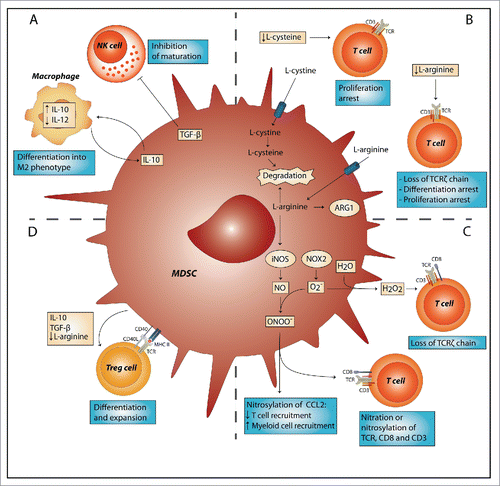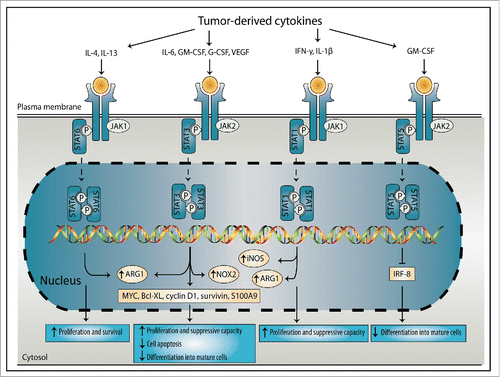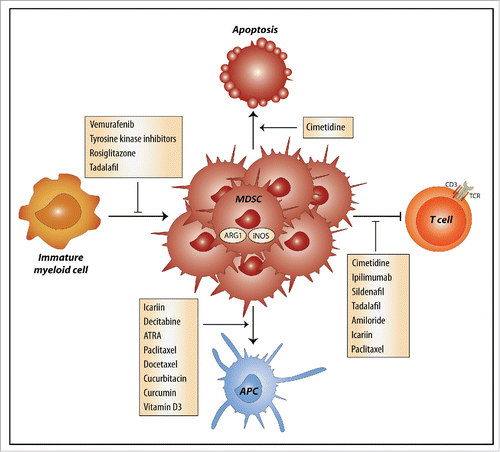Figures & data
Figure 1. MDSC-suppressive mechanisms target innate and adaptive arms of the immune system. (A) Myeloid-derived suppressor cells (MDSCs) can inhibit the innate immune system by TGF-β-induced inhibition of NK cell function and induction of a M2 macrophage phenotype by secretion of IL-10. (B) MDSCs deprive T cells of amino acids L-cysteine and L-arginine, which are essential for proliferation and differentiation. (C) MDSCs release reactive oxygen species, such as hydrogen peroxide (H2O2) and peroxynitrite (ONOO−). H2O2 causes loss of the T cell receptor (TCR)ζ-chain and peroxynitrite causes nitration and nitrosylation of chemokines like CCL2 and components of the TCR signaling complex, thereby both inhibiting T cell activation and recruitment. (D) MDSCs induce the development of regulatory T cells (Tregs) or expand existing Treg cell populations; these effects are mediated by interaction of the TCR with MHC-II and CD40 with CD40L. Furthermore, secretion of factors like IL-10 and TGF-β, and deprivation of L-arginine by MDSCs induce Treg polarization. ARG1, arginase 1; CCL2, chemokine (C–C motif) ligand 2; iNOS, inducible nitric oxide synthase; NOX2, NADPH oxidase 2; NO, nitric oxide; NK, natural killer; TGF-β, transforming growth factor-β; IL, interleukin.

Figure 2. Induction of MDSC expansion and suppressive functions by the STAT signaling proteins. Tumor-derived factors induce signal transducers of activators of transcription (STAT) signaling, which stimulated MDSC expansion and suppressive functions. IL-4 and IL-13 induce STAT6 that regulates ARG1, leading to enhanced MDSC proliferation and survival. IL-6, GM-CSF, G-CSF and VEGF induce STAT3 signaling, which regulates ARG1, NOX2 and the expression of factors like MYC, Bcl-XL, cyclin D1, survivin and S100A9. This leads to enhanced MDSC proliferation and suppressive capacity, reduced apoptosis and inhibition of differentiation into mature cells. IFNγ and IL-1β regulate STAT1 activation, which induces iNOS and ARG1 expression by MDSCs, leading to induced proliferation and suppressive capacity. STAT5 signaling is induced by GM-CSF and inhibits the differentiation of MDSCs into mature cells through inhibition of IRF-8. IL, interleukin; IRF, interferon regulatory factor; GM-CSF, granulocyte-macrophage colony-stimulating factor; G-CSF, granulocyte-colony stimulating factor; VEGF, vascular endothelial growth factor; IFNγ, interferon-γ; JAK, Janus kinase; ARG1, arginase 1; NOX2, NADPH oxidase 2; iNOS, inducible nitric oxide synthase; Bcl-XL, B-cell lymphoma-extra-large.

Figure 3. Mechanisms by which drugs and natural compounds inhibit MDSCs. Several drugs and natural compounds used in cancer treatment or for other indications have off-target effects that result in inhibition of myeloid-derived suppressive cells (MDSCs) through four distinct mechanisms. The off-target effects can inhibit expansion of MDSCs, inhibit their T cells suppressive capacity or induce the differentiation of MDSCs into mature APCs. Cimetidine induces the apoptosis of MDSCs. ARG1, arginase 1; iNOS, inducible nitric oxide synthase; APC, antigen-presenting cell; TCR, T cell receptor; ATRA, all-trans retinoid acid.

Table 1. Overview of drugs that target MDSCs.
